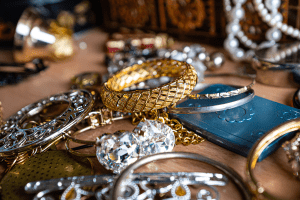Need quick cash? A jewelry loan can be your answer. It’s a simple way to unlock the value of your precious items without selling them. Many lenders offer competitive rates and flexible terms, making it easy to get what you need. You can use anything from quality jewelry like engagement rings to gold chains as collateral. The process is usually fast, so you won’t be left waiting around.
In this listicle, we’ll dive into the best options for jewelry loans available today. We’ll cover top lenders, interest rates, and customer experiences to help you make an informed choice. Ready to find the perfect loan? Scroll down for reviews of our top picks!
Key Takeaways

-
Always read and understand loan terms before signing anything to avoid surprises later.
-
Get your jewelry appraised by a professional to know its true value, which helps in securing a better loan.
-
Shop around and compare offers from multiple lenders to find the best interest rates and terms for your loan.
-
Don’t hesitate to negotiate interest rates with lenders; this can save you money over time.
-
Ensure your jewelry is secured properly while it’s with the lender to prevent loss or damage.
-
Research and check the reputation of lenders through reviews and ratings to ensure a trustworthy experience.
1. Understand loan terms
Jewelry loans come with specific terms that borrowers must understand. These loans typically require the jewelry to act as collateral. This means if you fail to repay the loan, the lender can keep your jewelry.
The duration of a jewelry loan often varies, ranging from a few weeks to several months. Borrowers should check for any penalties associated with late payments. Late fees can accumulate quickly, adding financial strain.
Defaulting on a jewelry loan has serious implications. Losing your jewelry is the most significant risk. Lenders may auction off the pieces to recover their losses. In some cases, they may charge additional fees or pursue legal action.
Factors influencing loan terms include the value of the jewelry and its condition. High-value pieces often lead to more favorable terms. For example, a diamond ring worth $5,000 might secure a larger loan than a less valuable piece.
Borrowers should also consider their ownership status. If you co-own the jewelry, all parties must agree to pawn it as collateral.
Understanding these aspects helps borrowers make informed decisions when considering a jewelry loan. Knowing the risks and requirements ensures you avoid unexpected challenges down the line.
2. Appraise jewelry value
Obtaining an accurate appraisal is crucial for anyone considering a jewelry loan. A professional appraiser evaluates the market value of your jewelry item based on various factors. This includes its condition, craftsmanship, and unique characteristics.
Start by seeking a reputable appraiser or professional jewelers who specialize in jewelry assessments. These experts have the knowledge to provide insights into current market trends and pricing. They can compare your piece to recent jewelry sales to determine its fair market value.
Understanding pricing trends helps you make informed decisions. Researching comparable sales can reveal how similar pieces are valued, which is essential for negotiating with jewelry buyers or lenders.
Consider the state of your jewelry as well. Shiny jewelry in excellent condition typically fetches higher values than items showing signs of wear. Unique attributes, such as rare gemstones or designer marks, also enhance worth.
Professional appraisals serve multiple purposes. Whether you plan to sell, insure, or use your jewelry for a loan, knowing its value empowers you in negotiations. Jewelry loans often require proof of worth through these appraisals.
In summary, accurate appraisals from experienced professionals ensure that you receive the best possible return on your exceptional jewelry when seeking a loan or selling it.
3. Compare multiple lenders
Evaluating different lenders is essential for securing the best jewelry loan terms. Start by comparing interest rates and loan amounts offered by various lenders. This step allows borrowers to understand the difference in financial options available.
Consider both local pawn shops and online lenders. Local pawn shops may provide immediate cash but often come with higher interest rates. Online lenders usually offer competitive rates and more flexible repayment terms. By exploring these options, borrowers can find a lender that fits their financial needs.
Analyzing customer reviews and ratings is crucial in gauging lender reliability. Look for feedback on service quality, responsiveness, and overall customer satisfaction. Reliable lenders often have positive reviews highlighting their transparency and fair practices.
Use comparison tools available online to create a shortlist of potential lenders. Focus on factors such as:
-
Interest rates
-
Loan duration
-
Fees associated with the loan
-
Customer service ratings
Gathering this knowledge helps in making an informed decision. It minimizes the risk of falling into unfavorable lending situations.
4. Negotiate interest rates
Negotiating interest rates on jewelry loans can significantly impact the overall cost of borrowing. Understanding the average interest rates for jewelry loans is crucial. Research typical rates in your area to gain leverage during discussions with lenders.
Present your jewelry’s value confidently. When you approach a lender, be ready to explain how you arrived at its worth. This knowledge helps justify a lower rate and positions you as an informed borrower. Highlight any unique features of your piece, like brand, rarity, or condition, to strengthen your case.
Leverage competing offers from other lenders. If you have received competitive offers, use them as bargaining chips in your negotiations. Mentioning these deals can encourage the lender to present better terms. A pawnbroker may be more willing to negotiate when they know potential buyers are considering multiple options.
Consider making counteroffers based on your research and competing rates. If a lender presents a high-interest rate, don’t hesitate to propose a fair price that aligns with market standards. This strategy shows that you are serious about finding the best deal.
In summary, effective negotiations require preparation and knowledge. Understand market rates, articulate your jewelry’s value, and utilize competing offers to secure favorable terms on your loan. By doing so, you can ensure that both parties feel satisfied in the transaction while saving money in the long run.
5. Secure jewelry properly
Secure jewelry properly before taking it to the lender. Quality jewelry requires special care, especially when transporting it. Use protective cases or soft pouches to avoid scratches and damage during transit. This simple step preserves the condition of your precious jewelry.
Documenting the condition of your jewelry is crucial. Take clear photos of each piece, highlighting any unique features or flaws. This record serves as proof in case of disputes about the state of your jewelry pieces when returned.
Consider the type of metals used in your jewelry. For instance, gold jewelry and silver jewelry may have different requirements for storage and handling due to their varying levels of purity and durability. Understanding these factors can prevent potential issues with lenders.
When selecting a lender, ensure they specialize in real jewelry. Look for those who have experience handling dazzling jewelry pieces and understand their value. Research their reputation and read reviews from previous clients to gauge their reliability.
Finally, keep your jewelry stash organized. Store similar pieces together, which makes it easier to assess what you plan to loan out. A well-managed collection reflects responsibility and enhances trust with lenders.
6. Check lender reputation
Lender reputation plays a crucial role in securing a jewelry loan. Investigate the lender’s history and track record in the industry. A reliable lender typically has a strong presence with many positive reviews online.
Look for complaints or legal issues that may indicate unreliable practices. Websites like the Better Business Bureau can provide insights into any unresolved issues. If a lender has numerous negative reviews, it is wise to consider alternatives.
Seek recommendations from friends or trusted online communities. Personal experiences often highlight the legitimacy of lenders. Many borrowers share their stories on forums, which can help identify trustworthy options.
Evaluate the quality of customer service as well. A reputable lender will be transparent about terms and conditions. They should clearly explain interest rates, fees, and repayment options. Understanding these factors helps avoid hidden costs later.
Check if the lender’s pricing aligns with industry standards. Compare offers from multiple lenders to ensure you receive a fair deal. This comparison can reveal significant differences in interest rates and loan terms.
In summary, assessing a lender’s reputation involves researching their history, reading reviews, and gathering personal recommendations. A trustworthy lender will demonstrate transparency and offer competitive pricing, ensuring a smooth borrowing experience.
7. Verify loan agreement details
Verify loan agreement details carefully to avoid misunderstandings. Read the loan agreement thoroughly to grasp all terms and conditions. This ensures you know your rights and obligations.
Confirm the total amount to be repaid. Include interest and any applicable fees in this calculation. Knowing the complete financial picture helps in planning repayments effectively.
Check that all verbal agreements are documented in writing within the contract. If any promises were made during discussions, they should appear in the final documents. This protects both parties and adds clarity.
Gather relevant documentation before signing. Collect proof of ownership, such as certificates or appraisals for valuable items. Such documents establish the sentimental value and worth of your jewelry, which can impact loan terms.
Consider including a clause that addresses what happens if you cannot repay the loan. This could involve penalties or loss of collateral. Understanding these details is crucial for making informed decisions.
In summary, verifying loan agreement details is essential for protecting your interests. Ensure you have all necessary documents and understand every aspect of the agreement before proceeding with a jewelry loan.
8. Consider insurance options
Insurance options play a crucial role when you opt for a jewelry loan. While your jewelry is held by the lender, having an insurance policy can provide peace of mind.
Evaluate various insurance policies that specifically cover jewelry during the loan period. Not all policies are created equal. Some may only cover theft or damage while others might include loss as well.
Assessing the cost of insurance against the value of your jewelry is essential. For instance, if your jewelry is valued at $5,000, a policy costing $100 annually may seem reasonable. However, if the premium is excessively high compared to its value, reconsider its necessity.
Review policy details thoroughly. Look for coverage limits and exclusions related to theft, loss, or damage. Policies often have specific clauses that could affect your claim in case of an incident.
The pawn industry typically requires some form of collateral insurance, making this step even more critical. A comprehensive policy not only protects your assets but also enhances your credibility with lenders.
In summary, exploring insurance options ensures that your valuable jewelry remains protected while securing a loan. This proactive measure can save you from potential financial loss in case of unforeseen events.
9. Know repayment terms
Understanding the repayment terms is crucial when taking out a jewelry loan. Familiarize yourself with the repayment schedule and deadlines set by the lender. Lenders often provide a specific timeline for payments, which can vary based on the amount borrowed.
Consequences exist for missing a payment. If you fail to pay on time, you risk forfeiting your jewelry. This means losing not just the cash you borrowed but also your valuable items. Establishments that offer jewelry loans typically require strict adherence to these terms.
Always keep track of your receipts and paperwork related to the loan. Maintaining a clear record helps in managing your repayments effectively. It also serves as proof of your transactions should any disputes arise.
Plan your finances around these repayment dates. Create a budget that allocates funds specifically for this purpose. This strategy ensures timely repayment and helps avoid additional fees or penalties associated with late payments.
Consider the condition of the jewelry when assessing its value against the loan amount. Lenders may evaluate the item’s state before approving the loan, impacting how much cash you can receive.
In summary, knowing the repayment terms protects both your finances and your jewelry. Stay informed about deadlines, maintain accurate records, and plan ahead to ensure a smooth loan experience without losing your precious items.
10. Seek expert advice
Consulting experts in jewelry loans can significantly enhance your understanding of the process. Financial advisors and jewelry specialists offer valuable insights tailored to your specific needs. They can help you navigate the complexities of securing a loan against your jewelry.
Discuss your situation openly with professionals. This dialogue allows them to provide personalized tips that align with your financial goals. Their expertise helps you make informed decisions, ensuring you feel confident about your choices.
Utilize online resources as well. Websites and forums dedicated to jewelry loans provide a wealth of information. These platforms often feature customer experiences, which can highlight potential pitfalls and advantages of various loan options.
When visiting a pawn store or jewelry lender, pay attention to their customer service. Quality treatment from staff reflects the store’s professionalism and commitment to customers. A knowledgeable team can answer questions and guide you through the loan process effectively.
Consider these factors when seeking expert advice:
-
Expertise matters: Choose professionals with a proven track record.
-
Tailored insights: Discuss your unique financial situation for better guidance.
-
Research resources: Leverage online articles and community forums for additional information.
Final Remarks
Navigating a jewelry loan can be straightforward if you follow the key steps outlined. Understanding loan terms and securing your jewelry properly are crucial. You want to ensure you’re making informed decisions that benefit you in the long run. Always compare lenders and negotiate rates to get the best deal possible.
Don’t forget to check lender reputations and verify all agreement details. Insurance options can provide peace of mind, while expert advice can guide you through the process. Take control of your financial future by applying these strategies today. Ready to secure that loan? Start your journey now!
Frequently Asked Questions
What is a jewelry loan?
A jewelry loan allows you to borrow money using your jewelry as collateral. If you fail to repay, the lender can keep your item.
How do I determine my jewelry’s value?
Get a professional appraisal from a certified jeweler. This ensures you understand its market value and can secure an appropriate loan amount.
Can I negotiate interest rates on a jewelry loan?
Yes, many lenders are open to negotiation. A good credit score and knowledge of current rates can help you secure better terms.
How should I secure my jewelry during the loan process?
Store your jewelry in a safe location, like a bank safety deposit box or a home safe, until the loan is finalized.
Why is checking lender reputation important?
A reputable lender ensures fair practices and transparency. Research reviews and ratings to avoid scams and high-interest loans.
What should I look for in a loan agreement?
Verify all terms, including interest rates, repayment schedules, and any hidden fees. Clarity on these details prevents future misunderstandings.
Should I consider insurance for my jewelry loan?
Yes, insuring your jewelry protects against loss or damage while it’s under the lender’s possession. This adds peace of mind during the loan period.

